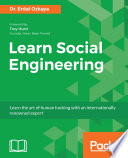

Social engineering is the art of manipulating people to obtain confidential information or access to systems. It relies on psychological tricks rather than technical hacking skills. The book emphasizes the importance of understanding human behavior, motivations, and the factors that lead individuals to divulge sensitive information. Techniques such as pretexting, phishing, and baiting are explored, showcasing how attackers often exploit trust and social norms. By grasping the fundamentals of social engineering, readers can better protect themselves and their organizations from such tactics.
Continue readingThe book delves into the psychological principles that underpin social engineering tactics. Concepts like reciprocity, authority, and scarcity are examined in detail. For instance, people are more likely to comply with requests from those they perceive as authoritative figures. The book provides insights into how emotions can be leveraged to manipulate decisions, such as creating a sense of urgency or fear. Understanding these psychological triggers can help individuals recognize when they are being manipulated and develop resilience against such tactics.
Continue readingA significant portion of the book is dedicated to outlining common social engineering techniques used by attackers. These include phishing emails, vishing (voice phishing), and smishing (SMS phishing). Each technique is described with real-world examples, illustrating how attackers craft their messages to appear legitimate. The book also discusses the importance of awareness and training in recognizing these techniques to prevent successful attacks. By familiarizing oneself with these methods, individuals and organizations can implement better security measures.
Continue readingThe book stresses the importance of creating a security-conscious culture within organizations. It highlights that technology alone cannot prevent social engineering attacks; human behavior plays a critical role. Strategies for fostering a culture of security awareness include regular training sessions, open communication about security policies, and encouraging employees to report suspicious activities. By promoting a proactive approach to security, organizations can significantly reduce their vulnerability to social engineering attacks.
Continue readingTo provide practical insights, the book includes various case studies and real-life examples of social engineering attacks. These narratives illustrate how attackers successfully exploited human weaknesses to gain unauthorized access to sensitive information. By analyzing these cases, readers can better understand the tactics used and the consequences of falling victim to such schemes. The lessons learned from these examples serve as cautionary tales, reinforcing the need for vigilance and preparedness.
Continue readingThe book also addresses the ethical implications of social engineering. While the techniques can be used for malicious purposes, they can also be employed for ethical hacking and security assessments. The distinction between ethical and unethical social engineering is explored, emphasizing the importance of consent and transparency. Readers are encouraged to consider the ethical ramifications of their actions in the context of social engineering, fostering a responsible approach to security practices.
Continue readingFinally, the book provides practical advice on how individuals can develop personal defense mechanisms against social engineering attacks. This includes tips on verifying the identity of individuals, being cautious with personal information, and recognizing red flags in communications. The emphasis is on empowering individuals to take charge of their security by being informed and vigilant. By adopting these practices, readers can enhance their personal security and contribute to a safer environment.
Continue reading